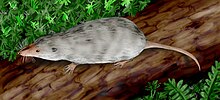Adelobasileus
| Adelobasileus Temporal range: Late Triassic,
| |
|---|---|

| |
| Life restoration | |
| Scientific classification | |
| Domain: | Eukaryota |
| Kingdom: | Animalia |
| Phylum: | Chordata |
| Clade: | Synapsida |
| Clade: | Therapsida |
| Clade: | Cynodontia |
| Clade: | Mammaliamorpha |
| Genus: | †Adelobasileus Lucas & Hunt, 1990 |
| Species: | †A. cromptoni
|
| Binomial name | |
| †Adelobasileus cromptoni | |
Adelobasileus is a genus of mammaliamorph cynodonts from the Late Triassic (Carnian to Rhaetian), about 225 - 220 million years ago. It is known only from a partial skull recovered from the Tecovas Formation in western Texas and partial specimen fossils from the Chinle Formation in Arizona, Southern United States. The species name is Adelobasileus cromptoni.
Adelobasileus predates and descends from the non-mammalian cynodonts Tritylodontidae and Tritheledontidae by 10 million years. Distinct cranial features, especially the housing of the cochlea, suggest that Adelobasileus is a transitional form in the character transformation from non-mammaliaform cynodonts to mammaliaforms. For this reason, it is thought to be a close relative of the common ancestor of all modern mammals. Though formerly classified as a mammal by trait-based taxonomy, it is outside the crown group containing all true mammals.[1]
References
[edit]- ^ Rowe, T. S. (1988). "Definition, diagnosis, and origin of Mammalia" (PDF). Journal of Vertebrate Paleontology. 8 (3): 241–264. doi:10.1080/02724634.1988.10011708.
Sources
[edit]- Lucas, SG; Hunt, AP (1990). "The oldest mammal". New Mexico Journal of Science. 30 (1): 41–49.
- Lucas, SG; Luo, Z (September 1993). "Adelobasileus from the upper Triassic of west Texas and central Arizona: the oldest mammal". J. Vertebr. Paleontol. 13 (3): 309–334. doi:10.1080/02724634.1993.10011512.
External links
[edit]






